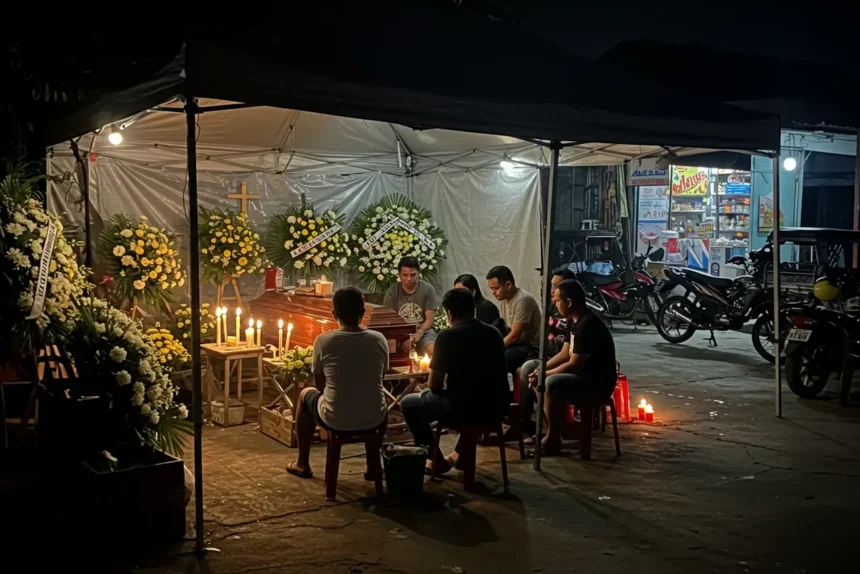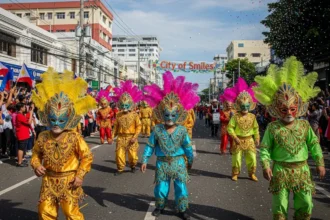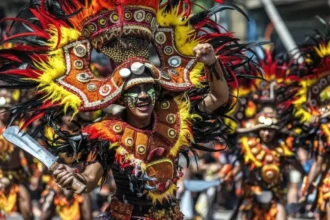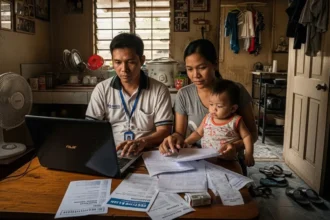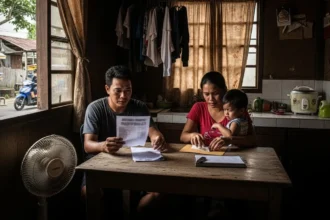In the Philippines, death is never met with silence. It’s greeted with prayers, stories, and the comforting smell of coffee brewed through the night. For Filipinos, a funeral isn’t just about loss – it’s about honoring life, remembering love, and keeping the departed close for one last goodbye.
- ☕ 1. The Lamay – All-Night Wake and Vigil
- 🕊️ 2. The Pa-Siyam – Nine Days of Prayer
- 🪔 3. The Apatnapung Araw – The 40th Day Tradition
- 🚫 4. Pagpag – The No-Going-Home Rule After a Wake
- 🕰️ 5. Covering Mirrors and Stopping the Clock
- 🖤 6. Funeral Attire and Mourning Colors
- 🚶♂️ 7. The Funeral Procession and Burial Customs
- 🚫 8. The “Bawal” After a Funeral – Superstitions and Taboos
- 🍵 9. Food and Hospitality at Filipino Wakes
- 🌼 10. Death Anniversaries and Remembering the Dead – Undas and Beyond
- ❓ FAQs About Filipino Wake and Funeral Traditions
- 🌺 Between Mourning and Memory
- 🧭 References
From the all-night lamay to the nine-day pa-siyam novena, every Filipino funeral blends faith, family, and pamahiin. Even small gestures – covering mirrors, stopping clocks, avoiding pagpag – carry meaning passed down through generations.
Whether held in a chapel or right in the living room, Filipino wakes and funerals are more than rituals; they’re acts of love and remembrance. In this article, we’ll explore 10 Filipino funeral customs and superstitions that reveal how we celebrate life, honor death, and find peace between the two.
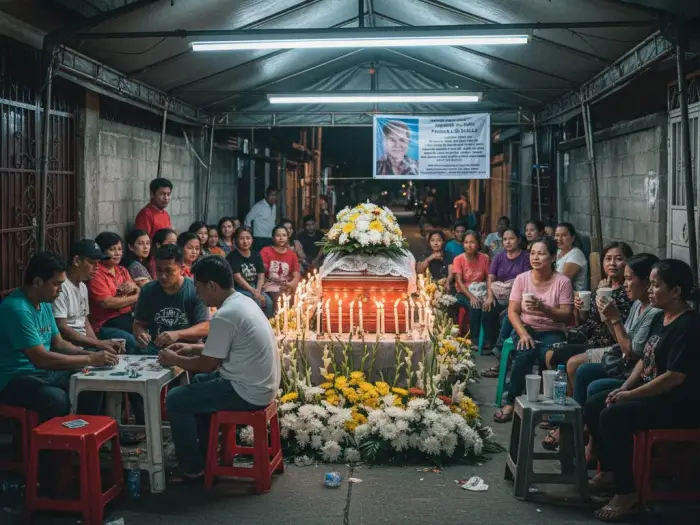
☕ 1. The Lamay – All-Night Wake and Vigil
In the Philippines, the lamay is the heart of every funeral – a time when family, friends, and neighbors gather through the night to keep vigil beside the departed. It’s part prayer, part storytelling, and part comfort for those left behind.
The word lamay means “to watch over,” and that’s exactly what happens. People come in shifts, bringing food, candles, and coffee to stay awake. Visitors offer condolences, join prayers, and share memories that often drift between laughter and tears. The vigil can last from three nights to a full week, depending on tradition or when the family is ready for burial.
Filipino lamay is a blend of devotion and community. There’s always a table of snacks – pandesal, kape, lugaw, or even pansit – to serve guests who come at all hours. It’s common to hear murmurs of the rosary followed by quiet chatter or even a deck of cards in the corner – because keeping spirits up (literally and emotionally) is part of the custom.
In rural areas, the lamay often takes place in the family home, the casket resting in the living room where children once played. In cities, it’s held in funeral chapels with round-the-clock visitation. Either way, the idea is the same: no soul should be left alone. The living keep watch not out of fear, but out of love – a final act of companionship before the journey to the next life.
🕊️ 2. The Pa-Siyam – Nine Days of Prayer
After the burial, the mourning doesn’t end – it continues through the nine-day novena known as pa-siyam, one of the most sacred Filipino death traditions. The word literally means “for nine,” symbolizing the nine days of prayers offered for the soul’s peaceful journey to the afterlife.
Every night, family and friends gather – either in the home of the deceased, at a chapel, or even online today – to pray the rosary and specific novena prayers. The ritual represents spiritual accompaniment: just as loved ones stayed beside the body during the lamay, now they accompany the soul in prayer.
Traditionally, the pa-siyam ends with a simple meal shared among attendees. Some serve pancit for long life or lugaw as a humble symbol of unity and comfort. The last night, known as the “last prayer” or huling gabi, often feels lighter – tears are replaced by quiet smiles and stories as the family slowly learns to let go.
There’s also deep symbolism behind the number nine – in Filipino Catholic belief, it reflects the stages of spiritual purification before the soul reaches heaven. In some provinces, families light candles every night until the ninth day, guiding the soul’s path home.
Even in modern times, pa-siyam remains a pillar of Filipino mourning – a bridge between grief and gratitude. Because for us, saying goodbye isn’t just a moment; it’s a prayer that stretches across days, echoing love until the soul finds peace.
🪔 3. The Apatnapung Araw – The 40th Day Tradition
In Filipino belief, the 40th day after death holds deep spiritual meaning. Known as the apatnapung araw, it marks the moment when the soul’s journey on earth finally ends – the day it is believed to ascend to heaven and reunite with God.
This tradition comes from both Catholic faith and ancient folk spirituality. According to the Bible, Jesus ascended into heaven 40 days after resurrection. Filipinos adapted this belief, saying that a soul lingers for 40 days to visit loved ones, resolve unfinished business, and say its silent goodbyes.
Families commemorate this day with a small mass or prayer gathering, often called the 40th day misa. Candles are lit, photos displayed, and favorite food of the departed is sometimes served as a gesture of remembrance. Some even prepare kakanin or pansit to share with guests, turning grief into quiet gratitude.
Many elders say that during those 40 days, signs of the departed may appear – a sudden scent of perfume, a flickering light, a familiar dream. These are seen not as hauntings but as gentle reminders that love remains.
When the 40th day arrives, families feel a bittersweet mix of sadness and relief. As one saying goes, “Sa ika-40 araw, tuluyan nang makakapahinga ang kaluluwa.” It’s the final farewell – a sacred close to mourning, and a hopeful prayer that the soul finds eternal peace.
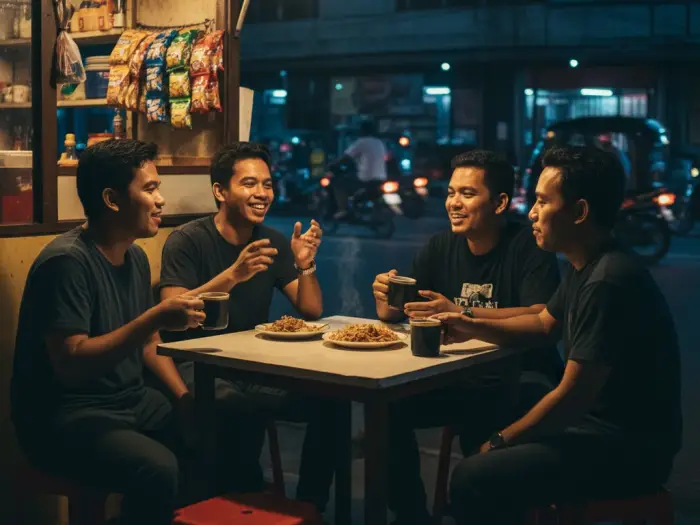
🚫 4. Pagpag – The No-Going-Home Rule After a Wake
Every Filipino knows this one – “Pagkatapos ng lamay, huwag muna diretsong uwi!” That’s the rule of pagpag, one of the most widely observed and feared pamahiin during funerals.
Pagpag literally means “to shake off” – and in this context, it’s a way to shake off bad luck or wandering spirits before returning home from a wake. The belief is that if you go straight home after visiting the dead, the spirit of the deceased (or other lost souls) might follow you back.
So instead, visitors stop somewhere else first – a convenience store, a fast-food joint, or even just a friend’s house – to “break” the trail. In older times, people might have simply walked around the block or clapped their hands before entering their home. Today, grabbing a burger at Jollibee or a coffee at 7-Eleven has become the modern version of pagpag.
Some say pagpag also symbolizes respect for boundaries – letting the dead rest and the living return to life slowly, not abruptly. Others view it as a way to lighten the heavy mood after the wake, to cleanse the spirit before coming home.
It’s a small gesture, but for many Filipinos, wala namang mawawala. Whether out of fear or faith, everyone does it – from the deeply religious to the skeptical millennial – because pagpag is more than superstition. It’s tradition, a collective sigh of relief that helps us transition from grief to the everyday world once again.
🕰️ 5. Covering Mirrors and Stopping the Clock
Walk into a traditional Filipino wake held at home, and you might notice something eerie yet respectful – mirrors covered with cloth and clocks stopped at the time of death. These gestures are small but deeply symbolic, rooted in both pamahiin and the Filipino sense of reverence for the departed.
Covering mirrors is said to prevent the spirit of the dead from getting “trapped” in reflections or showing themselves to the living. Elders warn that if a reflection appears during the wake, it could bring bad luck or startle mourners. Some also say it’s out of respect – no one should admire their reflection in front of the dead.
Stopping the clock, on the other hand, is a way to mark the moment of passing – freezing time, even briefly, to honor the life that has ended. It also symbolizes that life inside the home has paused for mourning, allowing the family space to grieve without distraction.
In some provinces, windows are kept slightly open so the soul can “find its way out.” Curtains may be drawn, candles left burning, and rosaries draped on the casket handles – each act an invitation for peace and safe passage.
Though many modern funerals skip these practices today, they remain powerful reminders of how Filipinos treat death – not with fear, but with galang (respect). Because even in sorrow, we try to keep the balance between the visible and the unseen, between goodbye and letting go.
🖤 6. Funeral Attire and Mourning Colors
In Filipino funerals, what you wear carries meaning. Black has long been the color of mourning – a quiet signal of grief and respect for the departed. But beneath this simple dress code lies a mix of faith, superstition, and emotional etiquette deeply woven into Filipino culture.
Traditionally, immediate family members wear black or white throughout the lamay and burial, often continuing for up to 40 days. Black represents mourning and loss, while white – also a common choice – symbolizes purity of the soul and peaceful farewell. Some families wear a small black ribbon pinned to their clothing as a subtle mark of bereavement.
Elders warn against wearing bright colors, especially red, during funerals. The belief says that red attracts spirits or symbolizes celebration – both considered disrespectful when mourning. Children are also told not to wear red, “para hindi sila lapitan ng espiritu.”
In rural areas, widows sometimes wear black for a full year (taong-luksa) as a sign of lifelong devotion and respect. Some even avoid jewelry or makeup during this period – a humble reflection of inner grief.
Modern Filipino funerals have relaxed these rules, with many opting for neutral tones or coordinated family colors. Still, the heart of the tradition remains: mourning clothes are not about fashion – they’re about empathy, reverence, and solidarity.
Because when we dress in somber tones, it’s not just to grieve – it’s to say, “We honor your life, and we carry your memory with quiet grace.”
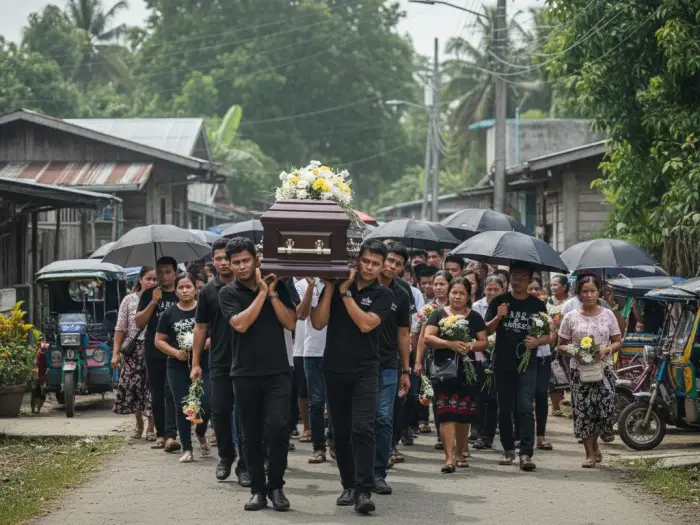
🚶♂️ 7. The Funeral Procession and Burial Customs
For Filipinos, the journey to the cemetery is more than a walk – it’s a sacred send-off. The funeral procession, often done on foot in rural towns, is a deeply emotional moment when the living accompany the dead for the very last time.
Traditionally, the casket is carried or transported slowly, led by a priest or minister reciting prayers. Family and friends follow behind, candles or flowers in hand, creating a solemn trail of faith and farewell. In the provinces, you’ll often see neighbors pausing by the roadside, crossing themselves as the procession passes – a quiet act of respect for both the deceased and the grieving family.
Elders say it’s bad luck to look back during the procession or to go ahead of the casket – “baka mahirapan ang kaluluwa sa pag-akyat.” Others toss coins or rice along the way, symbolizing blessings and abundance left behind for those still living.
At the cemetery, the burial is both painful and profound. Before the casket is lowered, loved ones place flowers, rosaries, letters, or personal mementos inside – tokens of connection that say “hindi kita nakakalimutan.” After the burial, attendees wash their hands with water mixed with guava leaves or vinegar before leaving the cemetery, believed to wash away kamalasan and spiritual heaviness.
Modern funerals may now involve motorcades, but the essence remains: to walk the last stretch with the one we love. Because for Filipinos, love doesn’t end at the graveyard – it simply learns to walk in prayer.
🚫 8. The “Bawal” After a Funeral – Superstitions and Taboos
After the funeral, Filipino families observe a long list of bawal – do’s and don’ts meant to protect the living and respect the dead. These customs blend Catholic reverence with folk beliefs that trace back centuries.
The most common is “Huwag munang magwalis sa bahay pagkatapos ng libing,” because sweeping right after the burial is said to sweep away blessings or the soul’s peaceful rest. Others say not to cook anything sour, like sinigang or paksiw, as it might bring more tears.
Mirrors are sometimes kept covered for nine days, and children are told to avoid playing loudly, “para hindi moistorbo ang kaluluwa.” Pregnant women, in particular, are advised not to attend funerals at all, out of belief that spirits might cling to them or affect the unborn child.
There’s also a gentle rule about avoiding new beginnings – no house moving, weddings, or parties during the mourning period. Many families wait until after the apatnapung araw (40th day) before celebrating anything major.
Even those who no longer believe in pamahiin still tend to follow these rules – out of habit, respect, or simply “wala namang mawawala.” These bawal are less about fear and more about slowing down, honoring grief, and giving space for both soul and heart to rest.
Because in Filipino culture, mourning is sacred time – not just for the one who passed, but for everyone learning how to go on living.
🍵 9. Food and Hospitality at Filipino Wakes
If there’s one thing constant at every Filipino lamay, it’s the smell of coffee and the sound of clinking cups. Food is not just offered – it’s shared freely, almost endlessly. Because in the Philippines, feeding the living is part of honoring the dead.
Throughout the wake, family and friends take turns serving guests who come to pay respects. There’s always kape for sleepless nights, pandesal or biscuits for quick bites, and sometimes lugaw or arroz caldo for comfort. In longer wakes, relatives prepare pancit, adobo, or even suman to sustain those keeping vigil.
The idea behind this hospitality is simple: mourning should never happen on an empty stomach. Offering food to visitors isn’t just about courtesy – it’s a way of saying “salamat sa pagdalaw,” and “samahan mo kami kahit sandali.”
In some provinces, there are rules about what not to serve. Dishes with vinegar or sour ingredients (sinigang, paksiw) are avoided because they symbolize tears. Meanwhile, sticky rice desserts like kakanin are believed to “bind” the family together during the grieving period.
Modern funeral chapels often provide food tables or coffee corners, but the essence remains the same: hospitality, even in sorrow. For Filipinos, eating together during a wake brings warmth, distracts from grief, and reminds everyone that life – like the coffee pot – keeps refilling itself.
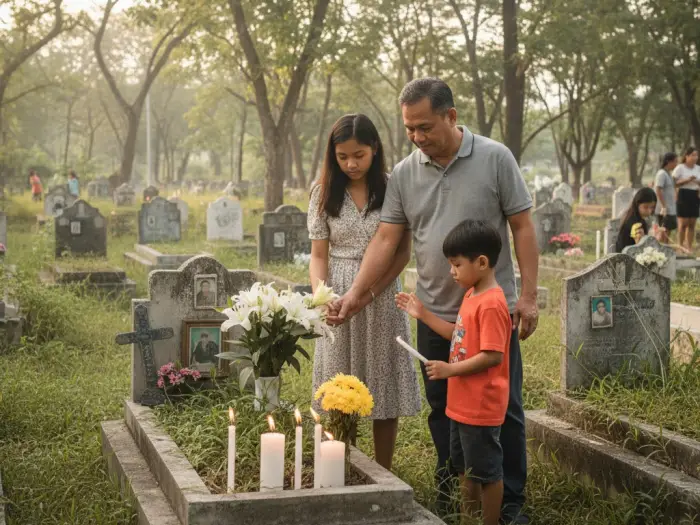
🌼 10. Death Anniversaries and Remembering the Dead – Undas and Beyond
For Filipinos, death doesn’t mark the end of connection – it begins a new kind of relationship. Long after the funeral and the 40th day, families continue to honor and remember their departed loved ones through annual traditions like Undas (All Saints’ and All Souls’ Day) and personal death anniversaries.
Every November 1 and 2, cemeteries across the Philippines come alive with candles, flowers, prayers, and laughter. Families bring puto, pancit, and the deceased’s favorite food, setting them on the grave like a shared meal. It’s not a somber event – it feels like a reunion, where the living and the departed meet halfway through memory.
Beyond Undas, many families quietly commemorate death anniversaries each year with a mass, novena, or small family dinner. Some light candles at home or post messages of remembrance online – a modern panalangin in the digital age.
In some provinces, there’s also the babang-luksa, marking the official end of mourning, usually a year after death. Families dress in lighter colors again, symbolizing acceptance and renewal.
Through these acts, Filipinos show that love endures – that remembering is a form of prayer. Because for us, the dead are never truly gone; they simply move into another room of the same home, still part of every story told and every candle lit.
❓ FAQs About Filipino Wake and Funeral Traditions
-
What is a Filipino lamay?
A lamay is an all-night wake where family and friends gather to keep vigil beside the deceased, offering prayers, food, and companionship until the burial. -
How long does a lamay usually last?
It can last from three nights to a full week, depending on family tradition and when the burial is scheduled. Some provinces even extend it up to nine days. -
What is the meaning of pa-siyam?
Pa-siyam is a nine-day novena of prayers after death, believed to guide the soul’s journey toward peace and heaven. -
Why do Filipinos observe the 40th day after death?
The 40th day marks the soul’s final ascent to heaven, mirroring Christ’s ascension. Families hold a mass or gathering to honor this spiritual milestone. -
What does pagpag mean in Filipino funeral customs?
Pagpag means stopping somewhere else before going home after a wake to shake off bad luck or prevent spirits from following you. -
Why are mirrors covered during a wake?
Mirrors are covered so the spirit of the dead won’t appear or get “trapped” in reflections, and as a sign of respect during mourning. -
Why do families avoid bright clothing during funerals?
Black or white symbolizes mourning and purity, while bright colors – especially red – are considered disrespectful or unlucky. -
What are common taboos after a funeral?
Families avoid sweeping, cooking sour dishes, or starting new ventures during the mourning period to preserve blessings and give space for grief. -
What foods are served during Filipino wakes?
Simple comfort foods like kape, pandesal, lugaw, or pancit are shared to sustain mourners and thank visitors for their presence. -
How do Filipinos remember their dead after the funeral?
Through Undas, annual death anniversaries, and prayers at home or church – reminders that love and memory outlast death itself.
🌺 Between Mourning and Memory
In the Philippines, death is never just an ending – it’s a continuation of love told through candles, prayers, and stories shared over coffee. Our wake and funeral traditions reveal who we are as a people: deeply faithful, family-centered, and unafraid to find warmth even in sorrow.
Every lamay, every pa-siyam, every flicker of candlelight reminds us that mourning doesn’t have to be silent – it can be communal, prayerful, and full of remembrance. We honor the dead by gathering, eating, laughing softly, and keeping their names alive in conversation.
Even the pamahiin – from pagpag to covered mirrors – serve one gentle purpose: to protect, to respect, and to make sense of loss the Filipino way.
Because in our culture, love doesn’t end at the grave. It lingers in the prayers whispered at night, in the 40th-day mass, in every All Souls’ visit to the cemetery. And maybe that’s the most beautiful thing – that even in grief, Filipinos never forget how to love, together.
🧭 References
-
Wikipedia – Funeral practices and burial customs in the Philippines
-
Quartz (QZ) – In the Philippines, mourners honor the dead by placing bets
-
The LaSallian – Crash Course: Funeral practices in the Philippines
-
Culture Trip – 9 Superstitions That Still Exist in Filipino Culture
-
Nation Thailand – A beginner’s guide to Filipino superstitions: Funeral edition



